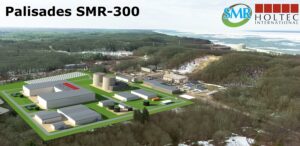PLYMOUTH — Gov. Maura Healey’s energy bill, now before the state legislature, contains a provision that would clear the way for development of new nuclear energy facilities in Massachusetts.

According to a May 24 Statehouse News Service report, the governor has said her goal is to broaden the state’s energy resources and lower costs.
The energy bill would repeal a 1982 law requiring voter approval on a statewide ballot prior to the construction and operation of new nuclear power plants. It would also do away with the state’s prohibition on new nuclear reactor construction until there is a federal repository to store the radioactive spent fuel.
Both possibilities have alarmed the region’s nuclear watchdogs, who have battled the three different owners of the Pilgrim Nuclear Power Station in Plymouth for over five decades — initially on plant safety and most recently on the possible release of contaminated water into Cape Cod Bay.
Those who oppose the repeal of the 1982 provisions are urging legislators to remove it from Healey’s energy bill.
“Citizens have every right to be fully invested in the decision-making as codified in this law,” said Diane Turco, president of the Cape Downwinders, in her written statement to the Joint Committee on Telecommunications, Utilities and Energy.
Mary Lampert, director of Pilgrim Watch in Duxbury, told the Independent in an email that the small modular reactors still produce high-level nuclear waste.
“Nuclear is the most expensive way to generate power,” Lampert said. “It produces long-lived, lethal waste, orphaned in Massachusetts with no federal repository in sight.”
Commercial plants nationwide are currently storing 90,000 tons of spent nuclear fuel in pools and dry casks.
Holtec Designs an SMR
Healey has said that the repeal of the 1982 law would not mark a return to reactors like Pilgrim, which shut down in 2019. Instead, it would open the door to new technology like the small modular reactors known as SMRs that can generate between 60 and 300 megawatts of power using nuclear fission.
Lampert said that Gov. Healey has been duped by nuclear industry promoters.
Holtec International, the company that owns Pilgrim and several other reactors undergoing decommissioning, has developed its own SMR design for a pressurized water reactor and has announced plans to install them on some of its plant sites.
Pilgrim still has its power transmission lines in place, which would save the company time and money, making it an attractive site for adding new reactors, confirmed Holtec spokesman Patrick O’Brien.
That worries those who followed the reactor’s trouble-plagued history, which includes a federally ordered shutdown from 1986 to 1988 for frequent equipment issues and emergency shutdowns, and its downgraded classification by the Nuclear Regulatory Commission in 2015 as the worst operating plant in the country. The plant was at that time one step away from mandatory shutdown.
Still Just on Paper
Nuclear reactors are expensive to build and maintain. Georgia’s Vogtle Units 3 and 4, the nation’s most recent large reactors to go online, took 15 years and $35 billion to construct, double the initial projected timeline and cost.
Advocates say the small reactors’ modular design allows for standardized components to be manufactured offsite, potentially making them cheaper and quicker to deploy.
Proponents also say the reduced size of the SMRs allows them to operate on much smaller tracts and in rural areas with less robust power grids. Modular units can also be added to existing traditional sites to meet increased energy needs.
But there is not a single commercial SMR currently operating in the U.S. Because so far they exist only on paper, David Lochbaum, former director of the nuclear safety program for the Union of Concerned Scientists said in an email to the Independent, “SMRs are the safest reactors ever. Their only hazard involves paper cuts.”
There are in fact only two operating in the world. Floating on a barge in Russia is a pair of 35-megawatt pressurized water reactors. China has a 125-megawatt pressurized water reactor.
All of the SMRs on the drawing board use the same nuclear fission process as the world’s current large-scale fleet to generate electricity, but some will use different cooling methods, such as helium, liquid metal, and molten salt.
Scott Burnell, spokesperson for the federal Nuclear Regulatory Commission, said only three commercial SMR applications are under review in the U.S. They are TerraPower’s proposal for a 345-megawatt molten salt reactor for a site in Wyoming; the Tennessee Valley Authority’s plan for a Hitachi 300-megawatt boiling water reactor at Clinch River, Tenn.; and Dow/X-Energy’s 80-megawatt, helium-cooled SMR, proposed to power Dow’s manufacturing facility in Texas.
Holtec is in the pre-application process for its SMR, a 300-megawatt pressurized water reactor design. The company projects commercial start-up of its first two SMR-300 units in 2030 and 2031 at its Palisades site in Michigan, where it is currently working to restart the existing 800-megawatt reactor that was shut down, then purchased by the company in 2022 for decommissioning. In January 2023, Holtec decided instead to refurbish and restart the reactor.
According to O’Brien, the cost estimate for dual units producing 640 megawatts is in the $6 billion range.
Holtec has a contract with Hyundai Engineering & Construction to build a 10-gigawatt fleet of SMR-300s. The company’s plan calls for 33 SMRs in North America in the 2030s, and it has already built a factory in Camden, N.J. to manufacture the modular parts.
O’Brien was vague on whether Holtec would install SMRs at Pilgrim. “Anything can happen, but I view it as a long shot option for now,” he said.
The company is discussing its SMRs as economic generators with locations outside of Massachusetts. “There are so many states with a real desire to provide clean, baseload power that the projects will go there, and other states will be left behind in a challenging situation to keep the lights on,” O’Brien said.
Disagreement Among Scientists
“There’s lots of uncertainty around them,” Allison Macfarlane, who chaired the Nuclear Regulatory Commission from 2012 to 2014, told the Independent in a July 16 interview about SMRs. That’s because of a dearth of data on their actual operation. “In the U.S. anyway, nobody’s completed even a demonstration model,” said Macfarlane. “We don’t know what they will cost in the end, the number of issues associated with waste production, some of the safety issues, and some of the security issues.”
Macfarlane, who served on the White House Blue Ribbon Commission on America’s Nuclear Future from 2010 to 2012 and is director of the School of Public Policy and Global Affairs at the University of British Columbia, said that Holtec’s proposal for a pressurized water reactor will be a lighter lift than some other designs because it uses the same technology as the nation’s large reactors and will benefit from an existing fuel supply chain.
The making of an SMR, she said, is a little more complex than simple downsizing, but it’s in the realm of the possible. She noted that NuScale Power’s 77-megawatt pressurized water reactor design was recently certified by the NRC.
“Whether it is economically viable is a completely different question,” Macfarlane said. Costs connected to the NuScale project resulted in the company and a group of municipalities who had signed on for the power to abandon their agreement in 2023.
To the claim that factory-fabricated standardized parts will make SMRs cheaper, Macfarlane said, “We do have factory-build experience in the U.S., and it didn’t go well.”
The modules for the large-scale Vogtle plant in Georgia were built in a Louisiana factory and consistently arrived at the reactor site with low-quality welds and other problems that had to be fixed, Macfarlane said, causing delays and cost overruns.
The National Academy of Sciences in May 2022 published results of research done at Stanford University and the University of British Columbia that concluded SMRs will generate more radioactive nuclear waste per unit of energy than existing reactors do. And some SMR designs that use other fuels and coolants than existing reactors could produce difficult-to-manage waste.
Macfarlane, a member of the research team, said designers and regulators need to understand the implications of the waste SMRs will produce.
Jacopo Buongiorno, a professor in nuclear science and engineering at Massachusetts Institute of Technology and the director of the Center for Advanced Nuclear Energy Systems (CANES), said SMRs “are certainly viable from a technical point of view.”
The cost is not so easy to gauge, but Buongiorno guessed that they can be built more quickly and for less money simply because there is less plant to build. “Whether that relates to a lower cost of electricity or a higher cost of electricity than traditional, large-scale reactors remains to be seen,” he said. “We don’t know whether they will be economically, commercially successful until we build a few and they start running.”
Buongiorno is not worried about the problem of radioactive spent fuel. He called the amount produced “minuscule,” and said that several European countries are well on their way to having repositories for spent fuel. “In the U.S., the process has been mismanaged over several decades,” he said, so that the waste is stored on commercial reactor sites, a situation he doesn’t see as a problem: “It’s stored safely and cheaply and could stay there for up to a century and then repackaged and stay for another century,” he said.
Buongiorno defended the Pilgrim nuclear plant’s performance. “I would say that plant ran safely like all the other plants in the U.S.,” he said. His trust in regulators is high: “The NRC will not allow plants to operate if they’re not run properly,” he said.
Opponents point to Pilgrim’s poor performance record, emergency and mandatory shutdowns, and equipment failures as evidence that gives them reason to doubt those conclusions.
Constructing the new nuclear reactors on existing nuclear sites could minimize opposition, in Buongiorno’s opinion. “Part of the public support will come from highlighting the economic benefit it would provide,” he said.
The Plymouth Independent reported on May 24 that when local officials raised the possibility of allowing SMRs at Pilgrim during a workshop meeting that month, they heard both support and resistance. According to that report, Plymouth Planning Board member Frank Mand said that while SMRs are new and innovative, their problems are still mostly unknown.
“We do know without a doubt that they would be controversial,” Mand said.
